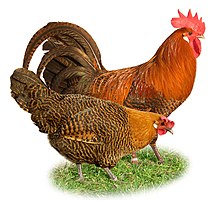Braekel
 | |
| Other names |
|
|---|---|
| Country of origin | Belgium |
| Use | eggs |
| Traits | |
| Weight | |
| Egg colour | white[2] |
| Classification | |
| APA | not listed[3] |
| EE | yes[4] |
| PCGB | rare soft feather: light[5] |
| |
The Braekel or Brakel is a traditional Belgian breed of chicken. It is thought to have originated in the area of Brakel, in the Flemish province of East Flanders, for which it is named.[6]: 43 There is a bantam version of the Braekel.[7] The Campine of the United Kingdom derives from it.
History[]
The Braekel apparently derives from same extended population of gold and silver chickens which gave rise to the closely similar Ostfriesische Möwe and Westfälischer Totleger breeds.[6]: 43 It is thought to have originated in the area of Brakel, in the Flemish province of East Flanders, and particularly in the villages of Opbrakel and Nederbrakel; and to have spread along the valleys of the Scheldt and Dender rivers, in East Flanders and into Hainaut.[6]: 43
In 1884 two distinct types were recognised as separate breeds: the larger Braekel of Flanders, and a smaller and lighter type from the Campine region to the east. In 1898 a Braekel breeders' society was established in Nederbrakel, and a breed standard was published. In 1926 the separate Braekel and Campine breeds were brought together again under a single breed standard.[6]: 43
In the United Kingdom a very different Campine breed was created, probably through cross-breeding with pencilled Hamburgs. The principal difference is that cock birds display hen-feathering, which was not seen in the Belgian type.[6]: 43
The Braekel population declined during and after the Second World War and it is a rare breed.
Characteristics[]
The Braekel is a light breed; cocks weigh 2–2.5 kg and hens 1.8–2.2 kg.[1] Bantam cocks weigh about 800 g and hens about 700 g.[7] Ring sizes are 18 mm and 16 mm for standard-sized cocks and hens, and 13 mm and 11 mm respectively for bantams.[7]
A straight banding pattern of the feathers and a uniform solid neck colour are characteristic of the Braekel. Several colour variants exist, with the gold and the silver variant being the most common.
Use[]
Braekel hens lay well from the age of six or seven months, and in a year may produce approximately 180 white-shelled eggs weighing 60–65 g.[6]: 44
References[]
| Wikimedia Commons has media related to Braekel. |
- ^ a b c Het Brakelhoen (in Dutch). Lierde: Braekelclub-Nederbraekel. Accessed August 2014.
- ^ Victoria Roberts (2008). British poultry standards: complete specifications and judging points of all standardized breeds and varieties of poultry as compiled by the specialist breed clubs and recognised by the Poultry Club of Great Britain. Oxford: Blackwell. ISBN 9781405156424. p. 84.
- ^ APA Recognized Breeds and Varieties: As of January 1, 2012. American Poultry Association. Archived 4 November 2017.
- ^ Liste des races et variétés homologuée dans les pays EE (28.04.2013). Entente Européenne d’Aviculture et de Cuniculture. Archived 16 June 2013.
- ^ Breed Classification. Poultry Club of Great Britain. Archived 12 June 2018.
- ^ a b c d e f N. Moula, M. Jacquet, A. Verelst, N. Antoine-Moussiaux, F. Farnir, P. Leroy (2012). Les races de poules belges (in French). Annales de Médecine Vétérinaire 156: 37-65. Accessed August 2014.
- ^ a b c Raskenmerken: De kenmerken van het brakelhoen (in Dutch). Brakelhoenspeciaalclub, 2011. Archived 29 May 2013.
- Chicken breeds originating in Belgium
- Chicken breeds
- Animal breeds on the GEH Red List
- Belgium stubs
- Poultry stubs